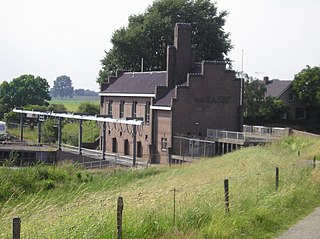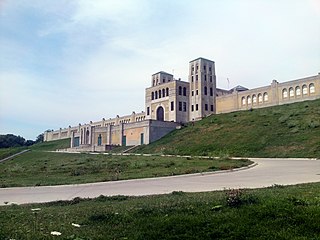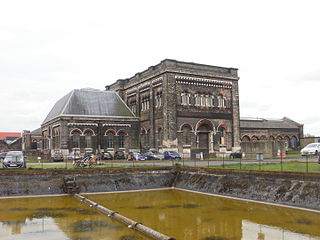
A sanitary sewer is an underground pipe or tunnel system for transporting sewage from houses and commercial buildings to a sewage treatment plant or disposal. Sanitary sewers are a type of gravity sewer and are part of an overall system called a "sewage system" or sewerage. Sanitary sewers serving industrial areas may also carry industrial wastewater. In municipalities served by sanitary sewers, separate storm drains may convey surface runoff directly to surface waters. An advantage of sanitary sewer systems is that they avoid combined sewer overflows. Sanitary sewers are typically much smaller in diameter than combined sewers which also transport urban runoff. Backups of raw sewage can occur if excessive stormwater inflow or groundwater infiltration occurs due to leaking joints, defective pipes etc. in aging infrastructure.

The London sewer system is part of the water infrastructure serving London, England. The modern system was developed during the late 19th century, and as London has grown the system has been expanded. It is currently owned and operated by Thames Water and serves almost all of Greater London.

Pumping stations, also called pumphouses in situations such as drilled wells and drinking water, are public utility buildings containing pumps and equipment for pumping fluids from one place to another. They are used for a variety of infrastructure systems, such as the supply of water to canals, the drainage of low-lying land, and the removal of sewage to processing sites. A pumping station is an integral part of a pumped-storage hydroelectricity installation.

Abbey Mills Pumping Station is a sewage pumping station in Mill Meads, East London, operated by Thames Water. The pumping station lifts sewage from the London sewerage system into the Northern Outfall Sewer and the Lee Tunnel, which both run to Beckton Sewage Treatment Works.

The Thames Tideway Tunnel is a 25 km (16 mi) combined sewer under construction, running mostly under the tidal section (estuary) of the River Thames across Inner London to capture, store and convey almost all the raw sewage and rainwater that currently overflows into the estuary. These events occur when rainfall volumes exceed the capacity of Bazalgette's and other engineers' London sewerage system. The tunnelling phase of the project was completed in April 2022.

The Toronto Works and Emergency Services department was responsible for a variety of services.

Toronto Water is the municipal division of the City of Toronto under Infrastructure and Development Services responsible for the water supply network, and stormwater and wastewater management in Toronto, Ontario, Canada, as well as parts of Peel and York Regions.

Stoke Bardolph is a village and civil parish in the Gedling district of Nottinghamshire. The population of the civil parish taken at the 2011 census was 170. It is to the east of Nottingham, and on the west bank of the River Trent. Nearby places include Burton Joyce and Radcliffe on Trent.

A combined sewer is a type of gravity sewer with a system of pipes, tunnels, pump stations etc. to transport sewage and urban runoff together to a sewage treatment plant or disposal site. This means that during rain events, the sewage gets diluted, resulting in higher flowrates at the treatment site. Uncontaminated stormwater simply dilutes sewage, but runoff may dissolve or suspend virtually anything it contacts on roofs, streets, and storage yards. As rainfall travels over roofs and the ground, it may pick up various contaminants including soil particles and other sediment, heavy metals, organic compounds, animal waste, and oil and grease. Combined sewers may also receive dry weather drainage from landscape irrigation, construction dewatering, and washing buildings and sidewalks.

The Crossness Pumping Station is a former sewage pumping station designed by the Metropolitan Board of Works's chief engineer Sir Joseph Bazalgette and architect Charles Henry Driver. It is located at Crossness Sewage Treatment Works, at the eastern end of the Southern Outfall Sewer and the Ridgeway path in the London Borough of Bexley. Constructed between 1859 and 1865 by William Webster, as part of Bazalgette's redevelopment of the London sewerage system, it features spectacular ornamental cast ironwork, that Nikolaus Pevsner described as "a masterpiece of engineering – a Victorian cathedral of ironwork".

Sewage farms use sewage for irrigation and fertilizing agricultural land. The practice is common in warm, arid climates where irrigation is valuable while sources of fresh water are scarce. Suspended solids may be converted to humus by microbes and bacteria in order to supply nitrogen, phosphorus and other plant nutrients for crop growth. Many industrialized nations use conventional sewage treatment plants nowadays instead of sewage farms. These reduce vector and odor problems; but sewage farming remains a low-cost option for some developing countries. Sewage farming should not be confused with sewage disposal through infiltration basins or subsurface drains.

The Western Treatment Plant is a 110 km2 (42 sq mi) sewage treatment plant in Cocoroc, Victoria, Australia, 30 km (19 mi) west of Melbourne's central business district, on the coast of Port Phillip Bay. It was completed in 1897 by the Melbourne and Metropolitan Board of Works (MMBW), and is currently operated by Melbourne Water. The plant's land is bordered by the Werribee River to the east, the Princes Freeway to the north, and Avalon Airport to the west. It forms part of the Port Phillip Bay and Bellarine Peninsula Ramsar Site as a wetland of international importance. The Western Treatment Plant treats around fifty percent of Melbourne's sewage — about 485 megalitres or 393 acre-feet per day — and generates almost 40,000 megalitres or 32,000 acre-feet of recycled water a year.

The ongoing pollution of the Ganges, the largest river in the Indian subcontinent, poses a significant threat to human health and the environment. The river, which is severely polluted with human waste and industrial contaminants, provides water to about 40% of India's population across 11 states, serving an estimated population of 500 million people, more than any other river in the world.

Sewage treatment is a type of wastewater treatment which aims to remove contaminants from sewage to produce an effluent that is suitable to discharge to the surrounding environment or an intended reuse application, thereby preventing water pollution from raw sewage discharges. Sewage contains wastewater from households and businesses and possibly pre-treated industrial wastewater. There are a high number of sewage treatment processes to choose from. These can range from decentralized systems to large centralized systems involving a network of pipes and pump stations which convey the sewage to a treatment plant. For cities that have a combined sewer, the sewers will also carry urban runoff (stormwater) to the sewage treatment plant. Sewage treatment often involves two main stages, called primary and secondary treatment, while advanced treatment also incorporates a tertiary treatment stage with polishing processes and nutrient removal. Secondary treatment can reduce organic matter from sewage, using aerobic or anaerobic biological processes. A so-called quarternary treatment step can also be added for the removal of organic micropollutants, such as pharmaceuticals. This has been implemented in full-scale for example in Sweden.

Effluent sewer systems, also called septic tank effluent gravity (STEG), solids-free sewer (SFS), or septic tank effluent drainage (STED) systems, have septic tanks that collect sewage from residences and businesses, and the liquid fraction of sewage that comes out of the tank is conveyed to a downstream receiving body such as either a centralized sewage treatment plant or a distributed treatment system for further treatment or disposal away from the community generating the sewage. Most of the solids are removed by the interceptor tanks, so the treatment plant can be much smaller than a typical plant and any pumping for the supernatant can be simpler without grinders.

Beckton Sewage Treatment Works, formerly known as Barking Sewage Works, is a large sewage treatment plant in Beckton in the east London Borough of Newham, operated by Thames Water.

The Cambridge Museum of Technology is an industrial heritage museum situated in Cambridge, England. The original building, a Scheduled Ancient Monument, housed a combined sewage pumping and waste destructor station built in 1894. The museum helps people to explore, enjoy, and learn about their industrial heritage by celebrating the achievements of local industries and the people who worked in them. The large site on the River Cam has green spaces for picnics and a fun, relaxed atmosphere for families. There are audio-visual displays, hands-on exhibits, and children's activities, as well as traditional museum displays and historic buildings. The Victorian Pumping Station with its original machinery showcases 19th-century engineering and technology. Displays on the forgotten industries of Cambridge reveal an alternative side of the city's history to the famous colleges. And the story is brought into the 20th century with exhibitions on innovative local companies in our new Pye building. Featuring Pye and Cambridge Scientific Instrument Company.

The history of water supply and sanitation is one of a logistical challenge to provide clean water and sanitation systems since the dawn of civilization. Where water resources, infrastructure or sanitation systems were insufficient, diseases spread and people fell sick or died prematurely.

Bransholme water works is a surface water storage and pumping station serving the Bransholme and Kingswood estates in Kingston upon Hull, England. The facility was originally built in the late 1960s for both surface and waste water, and included a storage lagoon and sewage works – the sewage works was replaced c. 2000 by a large waste water treatment facility near Saltend near the banks of the Humber Estuary.

The Crossness Sewage Treatment Works is a sewage treatment plant located at Crossness in the London Borough of Bexley. It was opened in 1865 and is Europe's second largest sewage treatment works, after its counterpart Beckton Sewage Treatment Works located north of the river. Crossness treats the waste water from the Southern Outfall Sewer serving South and South East London, and is operated by Thames Water.





















